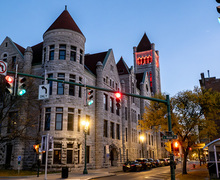Globe-trotting: Sustainable engineering club pursues domestic, international projects
Illustration by Andy Casadonte | Art Director
A SUNY-ESF club is traveling across borders to build environmentally friendly projects to help both poor communities and the eco-system.
The Engineering for a Sustainable Society club, formerly Engineers without Borders, at the State University of New York College of Environmental Science and Forestry, has gone to Honduras and Peru in the last 10 years, building projects that provide clean water, energy and green resources. The club went on its most recent trip on Sunday to Marietta, N.Y., and is expected to stay in touch with the community, even after the projects are finished.
The students get to work not only with each other, but also with professional engineers, non-governmental organizations and local residents, said Stewart Diemont, the club’s co-adviser.
One of the most important parts is working with the people living in the communities they visit, Diemont said. Sometimes projects don’t succeed because the engineers are working only with the technology, not the people, he added.
In Marietta, the group worked on a composting toilet for a local park.
The way the toilet works is that ammonia and sawdust are added to the waste after someone uses the toilet, said Theodore Endreny, the other co-adviser. Organic matter and nitrogen in the soil then work to decompose the waste until it’s converted into useful nutrients, he said.
About 2,000 miles away, in Honduras, the club is setting up a gravity-powered water system, Diemont said. This system will provide water to communities with limited access by piping water from mountains down to the villages, he said.
The system is set up in Buena Vista, a 300-person community, said Endreny, who traveled to Honduras with the club in 2010.
Before the project began eight years ago, the club needed to experiment on the stream to determine how much needed to be left to preserve the wildlife, he said. To better transport the materials needed for the system, Endreny said that the club set up a cable car that runs up and down the stream.
Moving materials this way, he said, is difficult.
“One time, we needed to take a basket over a turbulent river gorge to add it to the cable car,” Endreny said, which was “absolutely terrifying.”
The Honduras project cost about $30,000 in total, he said, not including the cost to the students. However, they received a grant from Anchor QEA, an environmental engineering consulting firm, and a grant from the National Science Foundation, he said.
In Peru, the club installed a hydroelectric generator that converts energy from a stream running through the village into electricity, Diemont said.
T.J. Decker, a junior environmental resource engineering major, said the hydroelectric generator produces enough energy to power an LED headlamp.
During the trip, Decker said he was fed a cooked guinea pig, as other guinea pigs ran around the hut.
“I ate the whole thing out of respect,” he said.
Diemont said that the projects encourage an interaction between students and people living in those communities that’s enlightening for the students, since the locals often bring a valuable knowledge of their own.
Said Diemont: “Collaboration between the two groups can be very enriching. They understand parts of the ecosystem that we don’t. We’re the ones who are learning here.”
Published on October 7, 2013 at 12:41 am





